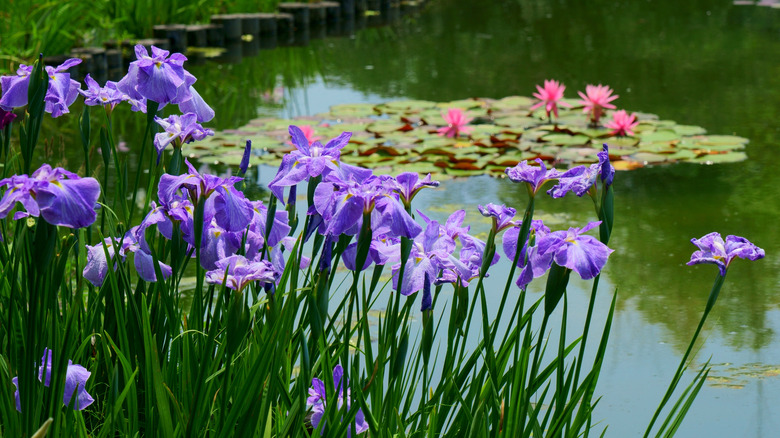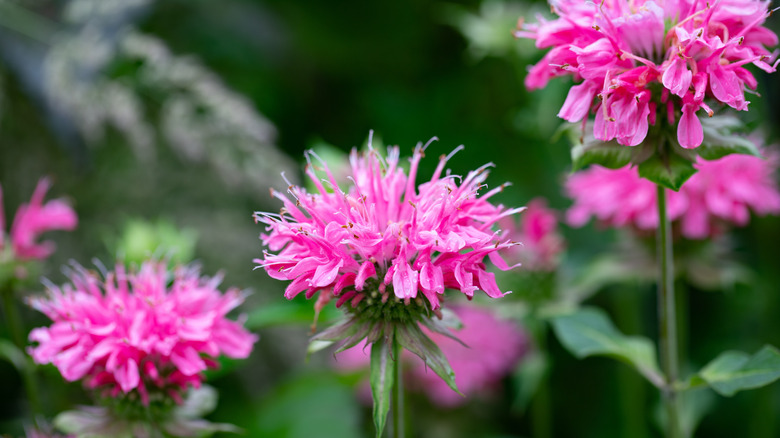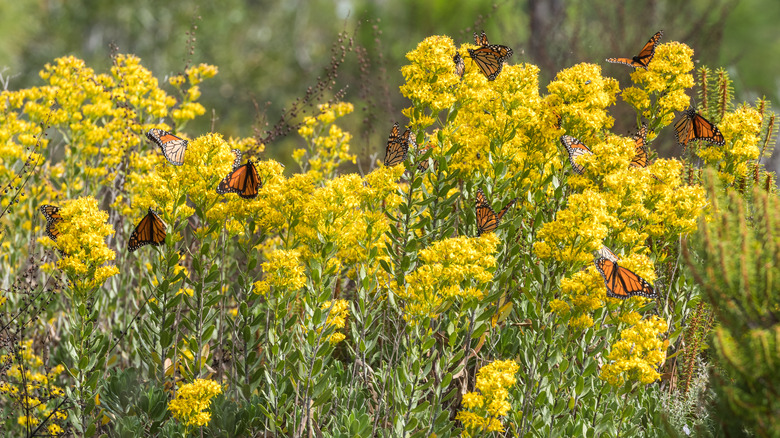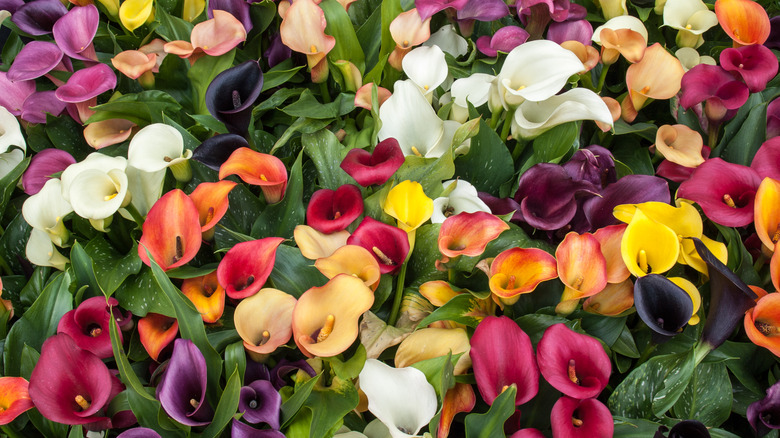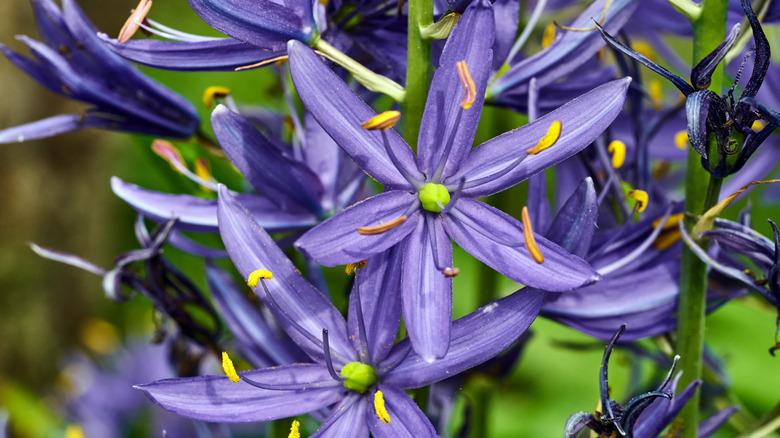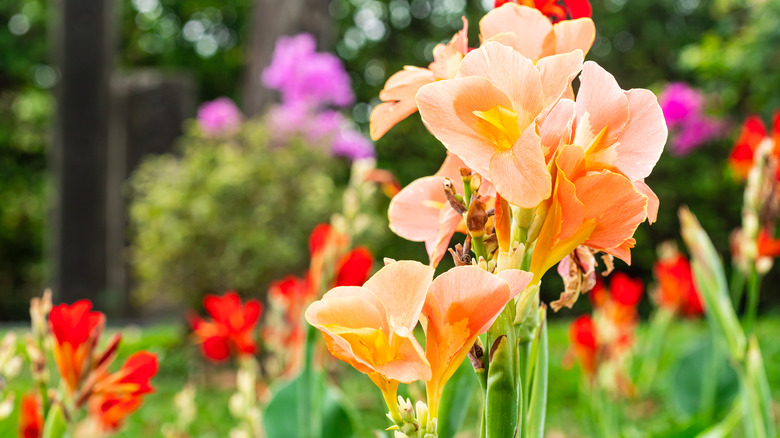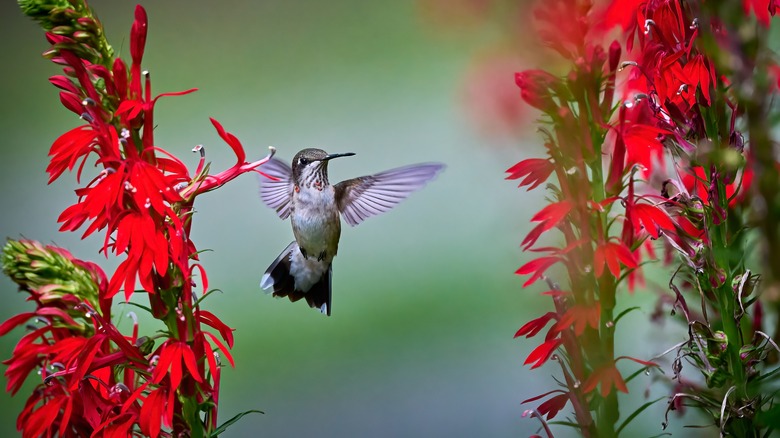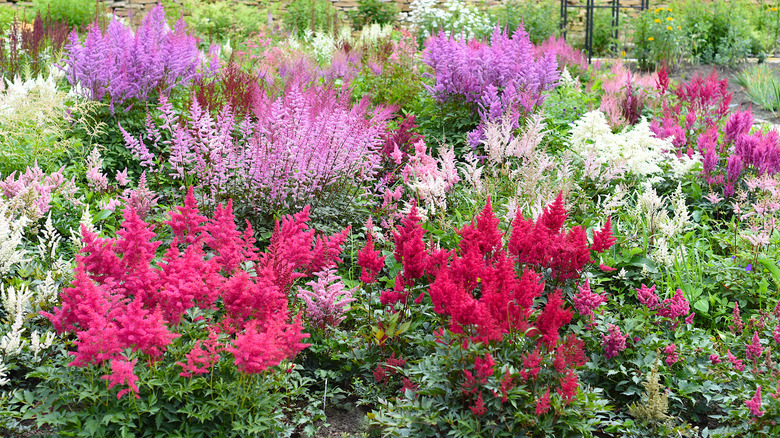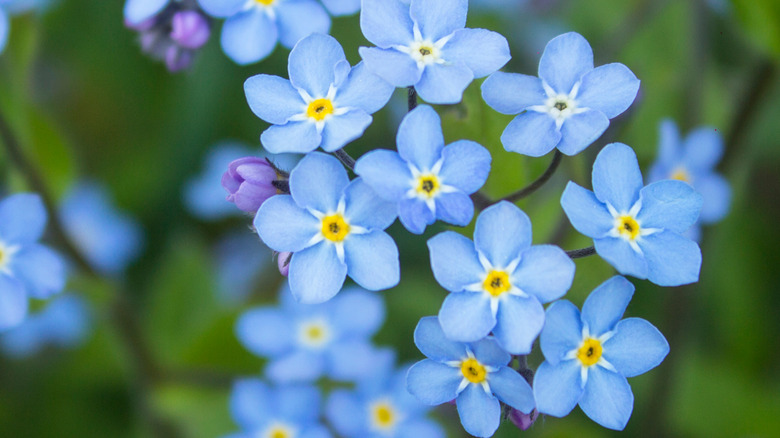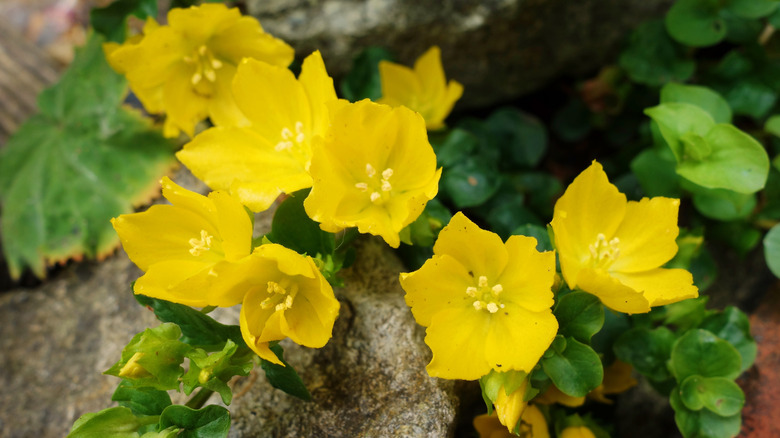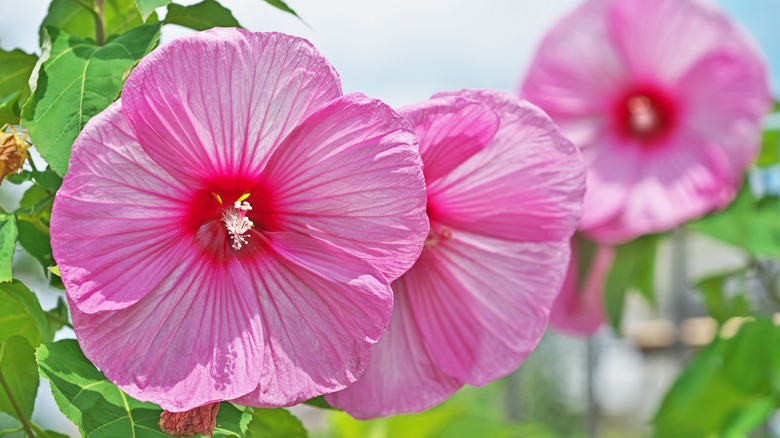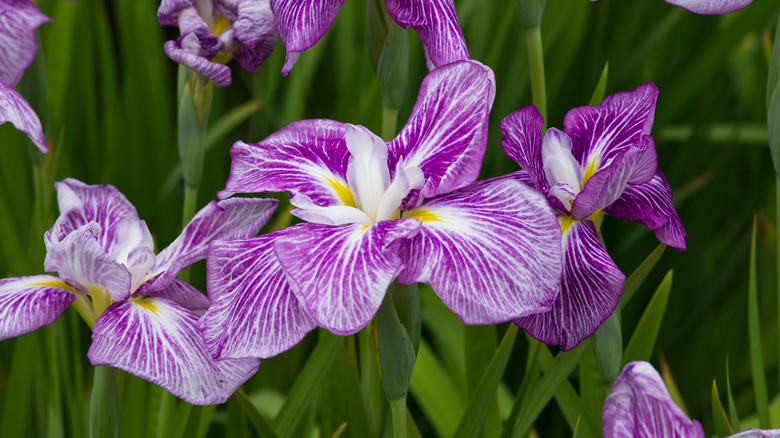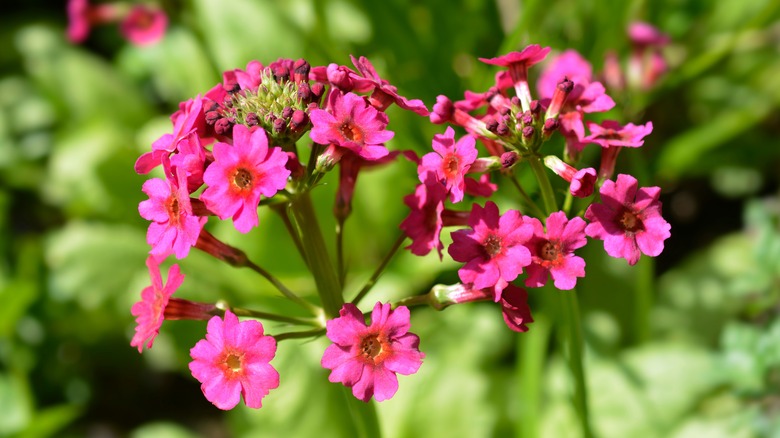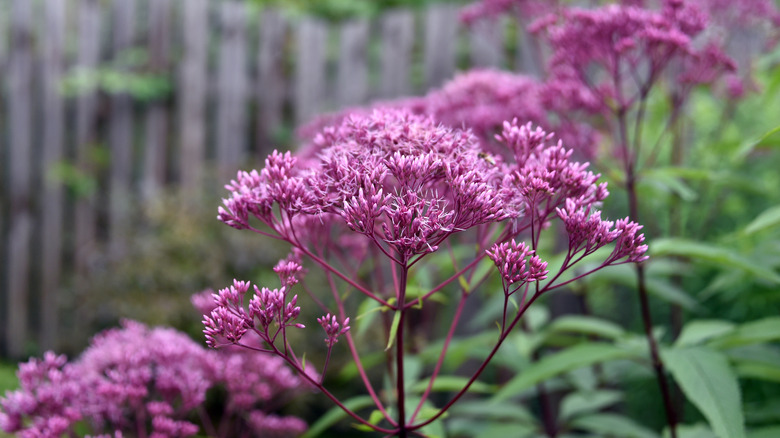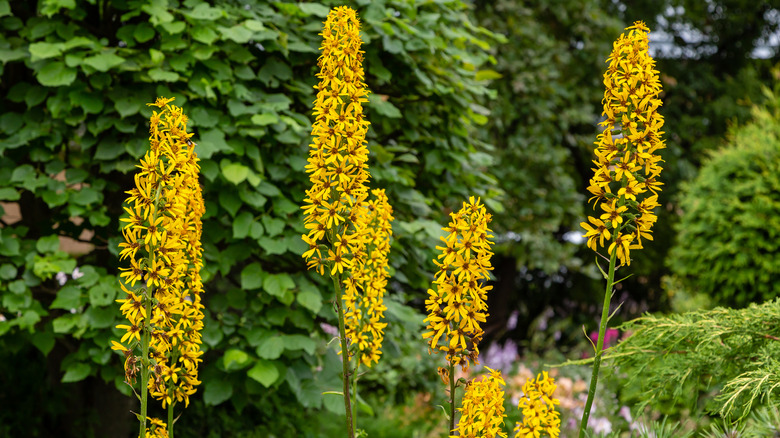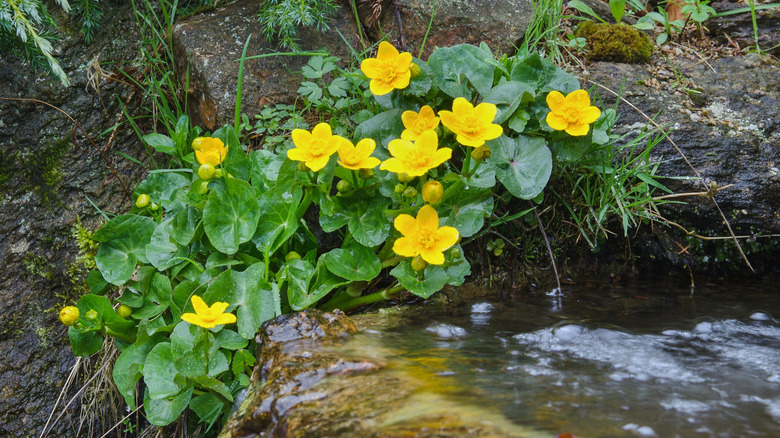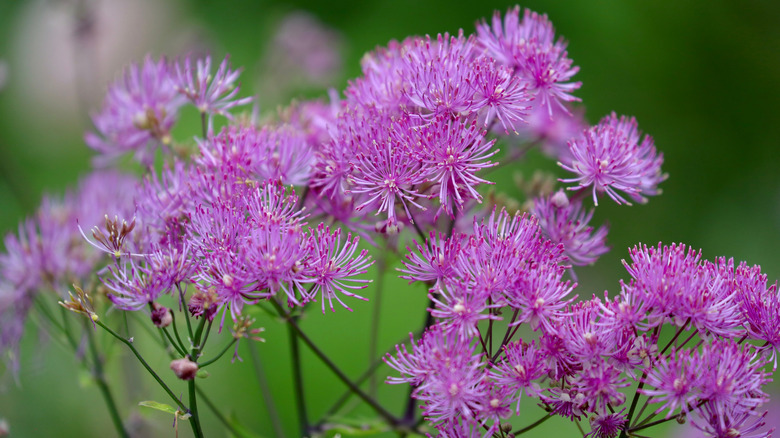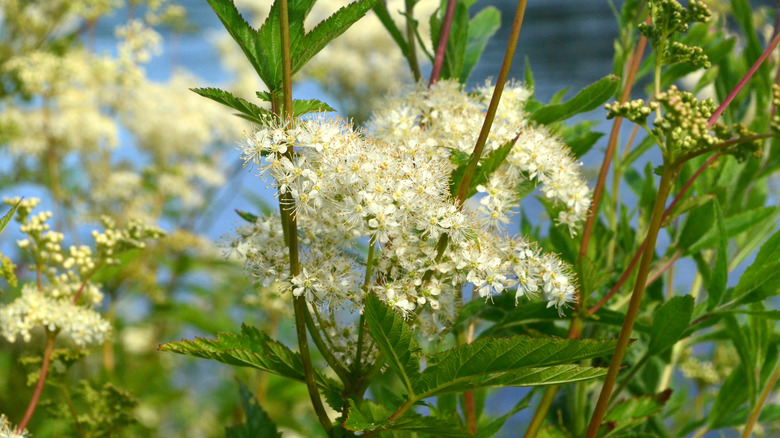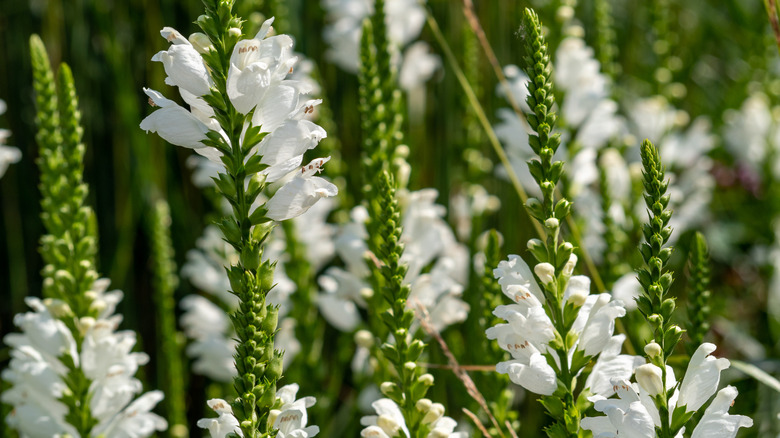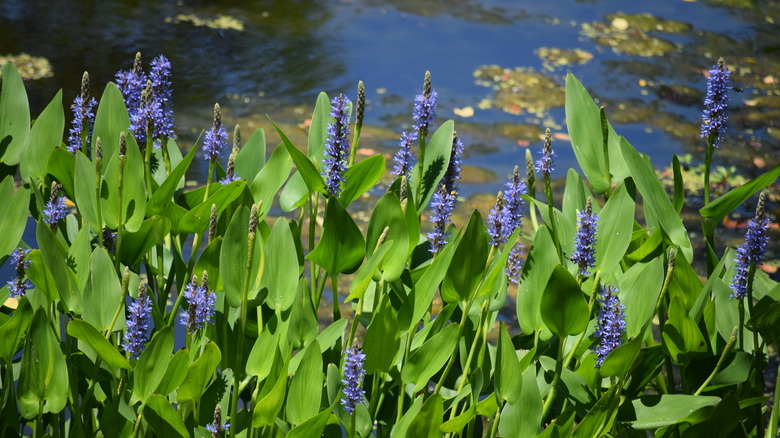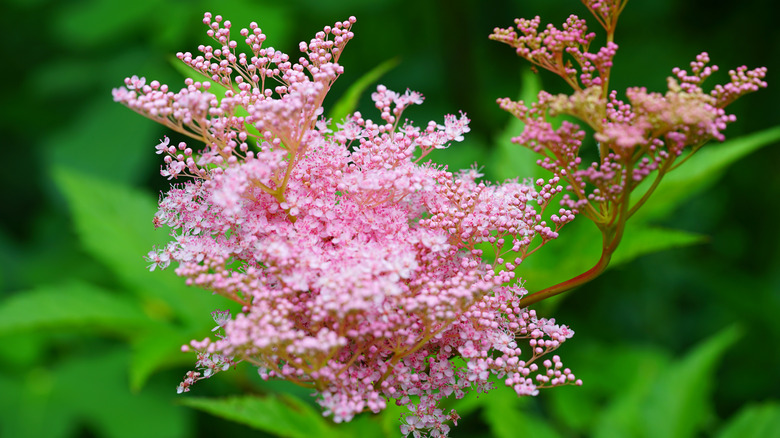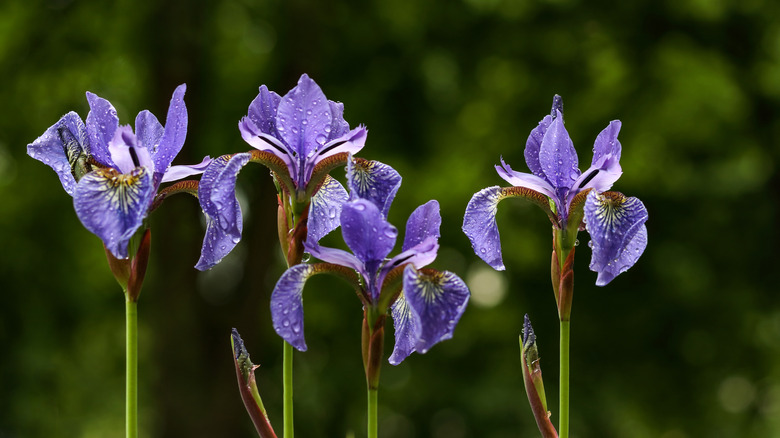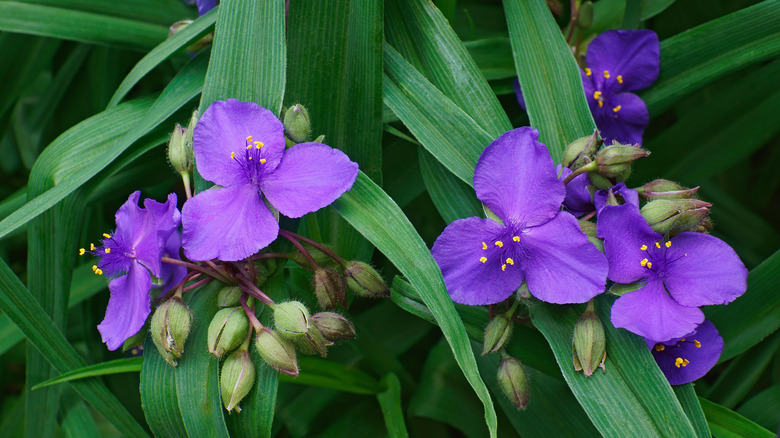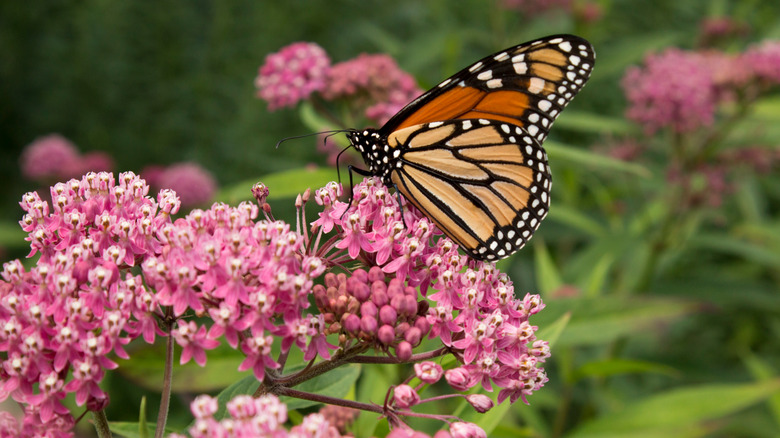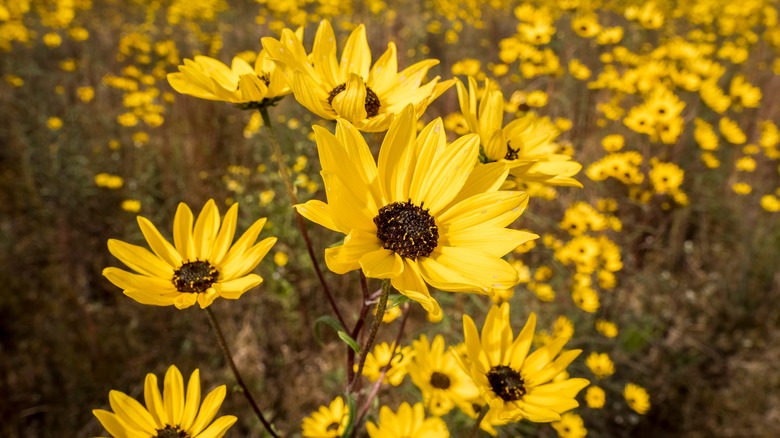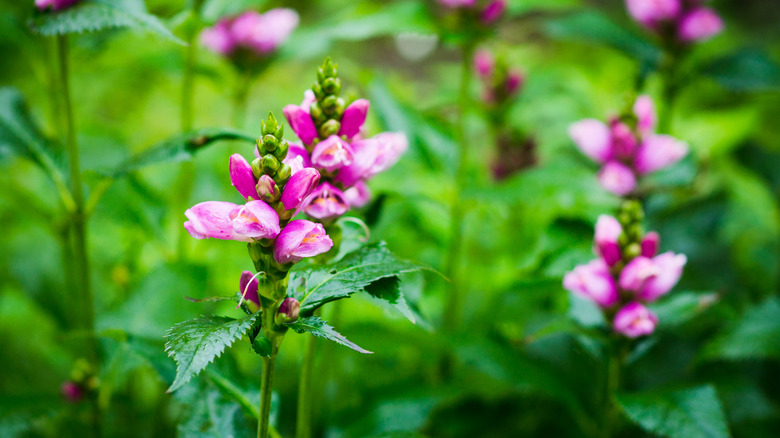25 Flowering Plants That Thrive In Soggy Soil
Conventional gardening wisdom points us towards well-draining soils for the healthiest plants, but we shouldn't forget about those unconventional flowers that appreciate less-than-ideal growing conditions. Irises, lilies, forget-me-knots, and a host of other species thrive endlessly in even the soggiest of situations. Flowering plants that like wet soil are often tall and brightly colored, so they can really liven up otherwise drab spots that homeowners tend to write off as dead spaces. And many of them grow from bulbs, rhizomes, or tubers and, therefore, can be easily propagated through root division.
In your own yard, soggy areas may appear where the downspouts from your home's gutters drain or around the artificial pond you intentionally installed in your backyard for decoration. Either way, with healthy flowers growing among the wet conditions, you can turn your garden into a dragonfly habitat. The flying hunters will make short work of any mosquito populations drawn to the water-logged areas, and their aerial antics will be fun to watch. So, if proper drainage is an unattainable feat in your yard, here are some gorgeous blooms that won't mind in the slightest.
1. Bee balm
Bee balm (Monarda didyma), also called bergamot or Oswego tea, produces edible crimson flowers that attract bees and can then help soothe a sting for the unlucky human who disturbs them. This brightly blooming plant can also be used medicinally as a digestive aid for nausea and bloating, as part of a raw cough syrup blend, and as an antimicrobial salve when combined with beeswax.
Bloom Season: Fall and summer
USDA Growing Zone: 4 to 9
Growing Conditions: Prefers full sun, tolerates moderate shade
Size: 2 to 4 feet tall and 2 to 3 feet wide
2. Bog goldenrod
Not every species of goldenrod can handle wet soil, but the one named bog sure can. Well-liked by butterflies yet not interesting at all to deer, bog goldenrod (Solidago uliginosa) is a tall plant with stems adorned with yellow plumes of flowers. It is commonly found along the east coast as far south as Georgia and as far north as Canada.
Bloom Season: Summer and fall
USDA Growing Zone: 3 to 7
Growing Conditions: Full sun to shade
Size: 2 to 5 feet tall
3. Calla lily
Zantedeschia aethiopica is the nearly impossible-to-pronounce botanical name for calla lilies. These beauties look like extra fancy tulips and come in a rainbow of colors from the deepest, darkest purples to the brightest yellows. All parts of these plants are toxic and considered poisonous to humans and pets, so handle them with extreme care.
Bloom Season: Summer
USDA Growing Zone: 8 to 10
Growing Conditions: Full sun to partial shade
Size: 2 to 3 feet tall and 1 to 2 feet wide
4. Camas
Camas (Camassia quamash) are also part of the lily family, yet they produce very different-looking flowers with bluish-purple petals and green button centers. Camas are common throughout the Pacific Northwest where native peoples have long harvested and sun-dried the roots for food.
Bloom Season: Spring
USDA Growing Zone: 4 to 8
Growing Conditions: Full sun to partial shade
Size: 1 to 2 feet tall
5. Canna
Cannas (Canna indica) are similarly named yet again, offering completely dissimilar flowers in shades of yellows, oranges, and reds. Cannas can grow extremely tall, up to 8 feet, and they attract typical daytime pollinators as well as nighttime pollinators like moths and bats. Achira starch from these plants is used to make cellophane noodles, and the leaves create the perfect tamale wrap.
Bloom Season: Fall and summer
USDA Growing Zone: 8 to 11
Growing Conditions: Full sun to partial shade
Size: 1 to 8 feet tall and 1 to 3 feet wide
6. Cardinal flower
If you're really into red, then you'll definitely want to plant cardinal flowers (Lobelia cardinalis). These bright statement blooms will attract hummingbirds, so couple them with a feeder. Let the cardinal flowers be the main attraction, though, and refrain from adding red dye to the sugar water that they feed on, as it may be harmful to the birds (via Cornell Lab of Ornithology).
Bloom Season: Spring, summer, and fall
USDA Growing Zone: 3 to 9
Growing Conditions: Full sun to partial shade
Size: Up to 6 feet tall
7. False goat's beard
False goat's beard (Astilbe biternata) is dioecious, meaning there are separate male and female plants, and you'll need to have both in your yard to ensure pollination. To get the most color, make sure you have an array of male plants because, just like male peacocks, they're the ones with the brightest and showiest displays.
Bloom Season: Spring and summer
USDA Growing Zone: 5 to 8
Growing Conditions: Dappled sun to partial shade
Size: 3 to 6 feet tall and 2 to 3 feet wide
8. Forget-me-not
Also called the water forget-me-not because it really likes to live by lakes and ponds, Myosotis scorpioides is the true forget-me-not of the plant kingdom. This plant offers delightful clusters of petite robin's egg blue flowers with contrasting yellow centers. It's the farthest thing from picky, happily growing anywhere from the bank of a stream to a ditch.
Bloom Season: Summer
USDA Growing Zone: 5 to 9
Growing Conditions: Full sun to partial shade
Size: 6 to 20 inches tall
9. Golden creeping Jenny
Golden creeping Jenny (Lysimachia nummularia 'Aurea') is a perennial ground cover that looks great year-round whether it's in bloom or not. Plant yours in full sun and its leaves will give its own flowers a run for their money in show-stopping yellow hues. Golden creeping Jenny works by a backyard pond structure where it will spread along rock edges, but know in advance that it's sometimes considered invasive.
Bloom Season: Summer
USDA Growing Zone: 3 to 9
Growing Conditions: Full sun to shade
Size: 2 to 6 inches tall and 12 to 18 inches wide
10. Hardy hibiscus
How do you know that this is the right hibiscus variety for your soggy soil? Well, for one, hardy hibiscus (Hibiscus moscheutos) is commonly referred to as the swamp rose mallow. Individual blooms can be a showy 9 inches wide and are generally pink or white. Rely on hardy hibiscus to increase tropical vibes.
Bloom Season: Summer and fall
USDA Growing Zone: 5 to 9
Growing Conditions: Full sun
Size: 3 to 7 feet tall and 2 to 4 feet wide
11. Japanese water iris
The Japanese water iris (Iris ensata) should not be confused with the more common bearded iris. This cultivar produces larger flowers that can be up to 10 inches wide and look more like orchids than irises. Standing water is fine for these plants throughout spring and summer, but come winter time you'll want to make sure the soil is drained. Otherwise, grow them in pots that can be moved.
Bloom Season: Summer
USDA Growing Zone: 5 to 9
Growing Conditions: Full sun to partial shade
Size: 2 to 4 feet tall and 1 to 2 feet wide
12. Japanese primrose
Perky pink whorls of Japanese primroses (Primula japonica) will brighten up a landscape and your mood. Thick upright stems display the flowers 18 inches above the plant's foliage making them look like large lollipops from afar. Japanese primrose is considered easy to grow by seed and, once established, it will continue to self-seed.
Bloom Season: Spring and summer
USDA Growing Zone: 4 to 8
Growing Conditions: Full sun to partial shade
Size: 1 to 2 feet and 1 foot wide
13. Sweet Joe pye weed
Perhaps one of the prettiest flowers to ever be called a weed, sweet Joe pye weed (Eutrochium purpureum) grows as high as 7 feet. It tends to be appreciated for the color it adds to the darker areas of a landscape, yet two of the best things about Joe pye weed are that it smells like vanilla and it brings all the butterflies to the yard.
Bloom Season: Summer and fall
USDA Growing Zone: 4 to 8
Growing Conditions: Light shade to partial sun
Size: 3 to 7 feet tall
14. Ligularia
Got a seriously shady spot that could really use some razzle dazzle? For eye-catching color and a unique overall look, seek out ligularia flowers, of which there are a few different varieties. Liguliara stenocephala, specifically, is commonly known as rocket ligularia and it's popular because it offers spectacular height over the others.
Bloom Season: Summer
USDA Growing Zone: 5 to 8
Growing Conditions: Partial shade, does not tolerate harsh sunlight
Size: Up to 6 feet tall and wide depending on the cultivar
15. Marsh marigold
Delightful yellow marsh marigolds (Caltha palustris) love to grow alongside creeks, so they'll be a perfect fit for the soggiest spot in your yard. The word palustris (species epithet) actually translates to swampy, marshy, or of wet places. Be careful with this one because it's toxic when consumed by humans, cattle, and horses.
Bloom Season: Spring and summer
USDA Growing Zone: 3 to 7
Growing Conditions: Full sun to partial shade
Size: 8 to 24 inches tall
16. Meadow rue
Meadow rue (Thalictrum aquilegiifolium) is another dioecious plant requiring both male and female plants for pollination. And again, the male plants will produce more impressive panicled and lilac-hued flowers. Provided it's cool enough, meadow rue can tolerate full sun exposure. Otherwise, plant it somewhere with significant shade coverage.
Bloom Season: Spring and summer
USDA Growing Zone: 5 to 8
Growing Conditions: Full sun to partial shade
Size: 2 to 3 feet tall and wide
17. Meadowsweet
Meadowsweet (Filipendula ulmaria) is just as delightful as its name makes it sound. The fragrant white blossoms are used to flavor herbal teas and alcoholic beverages, and the rest of the plant is edible as well. The medicinal history of meadowsweet can be traced back to the Druids. To this day it continues to be used as a digestive aid and anti-inflammatory.
Bloom Season: Summer
USDA Growing Zone: 3 to 9
Growing Conditions: Full sun to partial shade
Size: Up to 4 feet tall and 1 foot wide
18. Obedient plant
With all the uncontrollable chaos of modern-day life it's kind of funny to think about cultivating obedient plants. Physostegia virginiana is sometimes called a false dragonhead but its more common name of the obedient plant was bestowed upon it because its flowers will grow in whatever direction you bend and twist them into. Flowers on the 10-inch spikes can be white, pink, or purple.
Bloom Season: Summer
USDA Growing Zone: 8 to 11
Growing Conditions: Full sun
Size: Up to 4 feet tall
19. Pickerel rush
Each pickerel rush (Pontederia cordata) produces a single 6-inch spike of bluish-purple flowers. Classified as an emergent aquatic, it will grow best if its roots grow down into soil that is submerged underwater (i.e. the bottom of a pond). It can be grown in deep pots too, and it's one plant that will be happiest if you forget everything you learned about proper drainage.
Bloom Season: Summer and fall
USDA Growing Zone: 3 to 10
Growing Conditions: Full sun
Size: 24 to 30 inches tall
20. Queen of the prairie
With 8-inch clusters of pretty pink flowers, it's easy to see how queen of the prairie (Filipendula rubra) will become royalty around the backyard pond. If wet conditions make you think of grey skies and dreary weather, count on these wildflowers to illuminate your day. Even the stems are colorful sporting red stripes against lime green.
Bloom Season: Summer
USDA Growing Zone: 3 to 9
Growing Conditions: Full sun to partial shade
Size: 3 to 6 feet tall
21. Siberian iris
Just like Siberian huskies, the Siberian iris (Iris sibirica) can handle the cold; this plant grows as far north as USDA zone 3 across the U.S. border to Canada. It's similar to but much smaller than the Japanese iris which prefers slightly warmer weather and produces flowers three times as big. But if it's cold and particularly wet where you live, opt for the Siberian cultivar.
Bloom Season: Spring and summer
USDA Growing Zone: 3 to 8
Growing Conditions: Full sun, will tolerate moderate shade
Size: 2 to 4 feet tall and 1 to 2 feet wide
22. Spiderwort
The pretty purple flowers of the spiderwort plant (Tradescantia virginiana) are edible and the roots and leaves can be used as a medicinal herb to help heal digestive issues. This is a perfect option for shaded areas because it will flower and thrive even without direct sunlight.
Bloom Season: Spring, summer, and fall
USDA Growing Zone: 4 to 9
Growing Conditions: Full sun to full shade
Size: 2 to 3 feet tall and up to 1 foot wide
23. Swamp milkweed
With a name like swamp milkweed (Asclepias incarnata) you can be sure this flower will fare just fine in soggy soil. But there's more — planting swamp milkweed is one of the most important things you can do to support the monarch butterfly population because it acts as the butterflies' larval host plant.
Bloom Season: Summer and fall
USDA Growing Zone: 3 to 9
Growing Conditions: Full sun to partial shade
Size: 3 to 5 feet tall and 2 to 3 feet wide
24. Swamp sunflower
Yes indeed, there's a swamp-friendly variety of sunflower (Helianthus angustifolius). The blooms on these cultivars are much smaller than common sunflowers but the plants themselves can still grow to 8 feet tall. Along with wet conditions, swamp sunflowers prefer to grow in acidic loam with a high sand or clay content.
Bloom Season: Summer and fall
USDA Growing Zone: 5 to 9
Growing Conditions: Full sun to partial shade
Size: 5 to 8 feet tall and 2 to 4 feet wide
25. Turtlehead
We're not quite sure why Chelone obliqua is known as the red turtlehead, especially considering that its blossoms are usually pink or purple, but we do think it's a very cute flower. This one is a good option for that wet and shady area where you can't get anything else to grow. Consider this a must-grow if you have a backyard pond.
Bloom Season: Summer and fall
USDA Growing Zone: 5 to 9
Growing Conditions: Full sun to partial shade
Size: 2 to 3 feet tall and 1 to 2 feet wide
